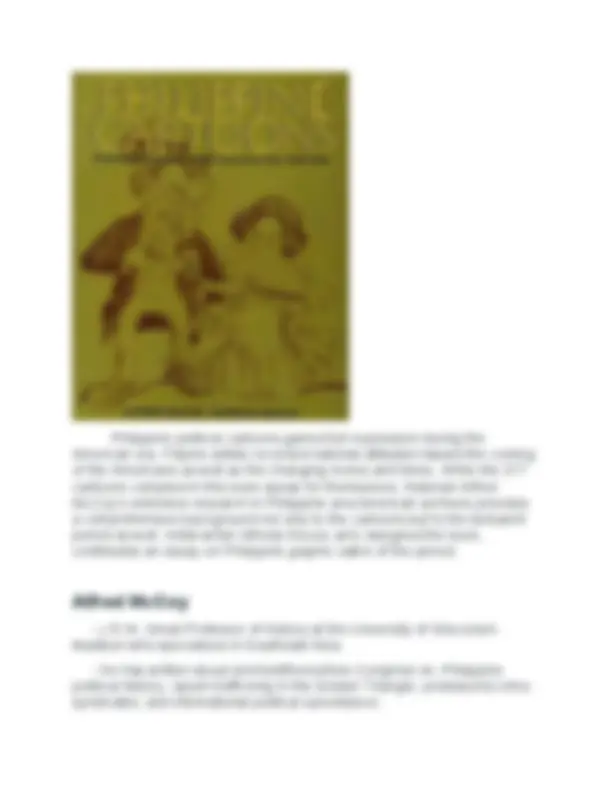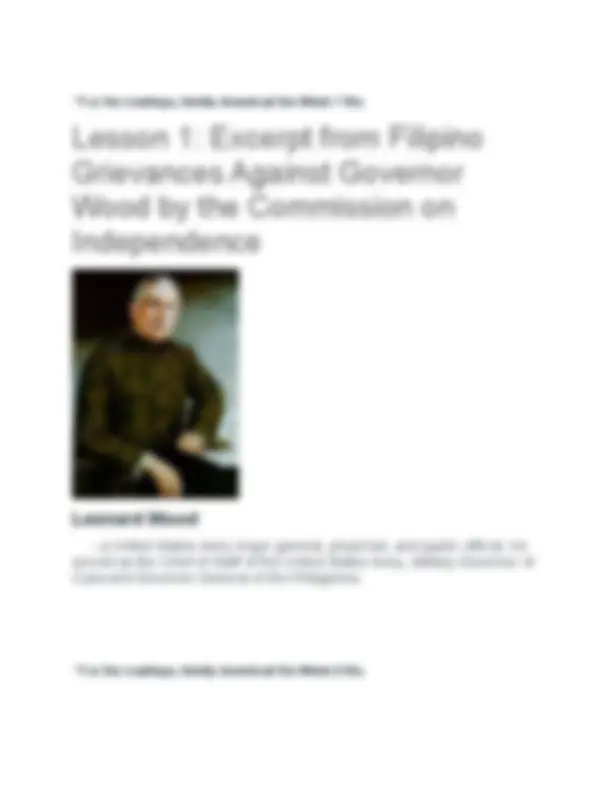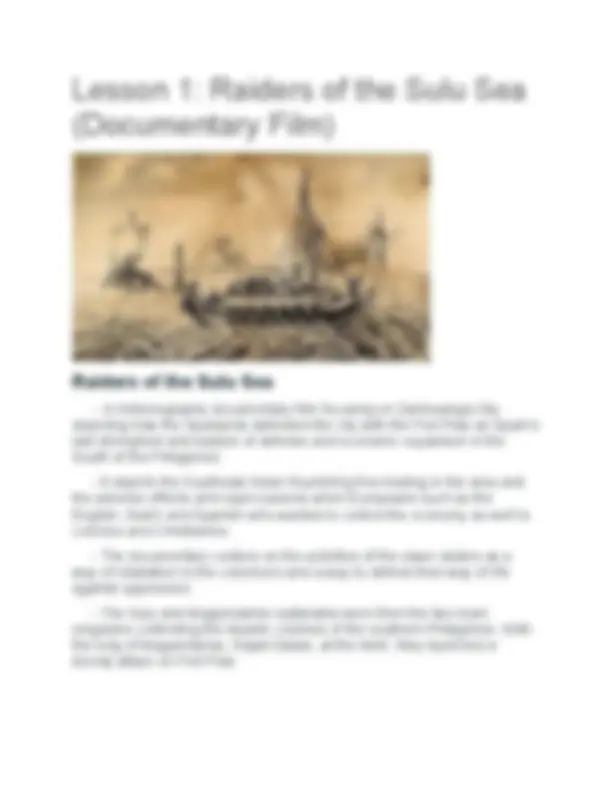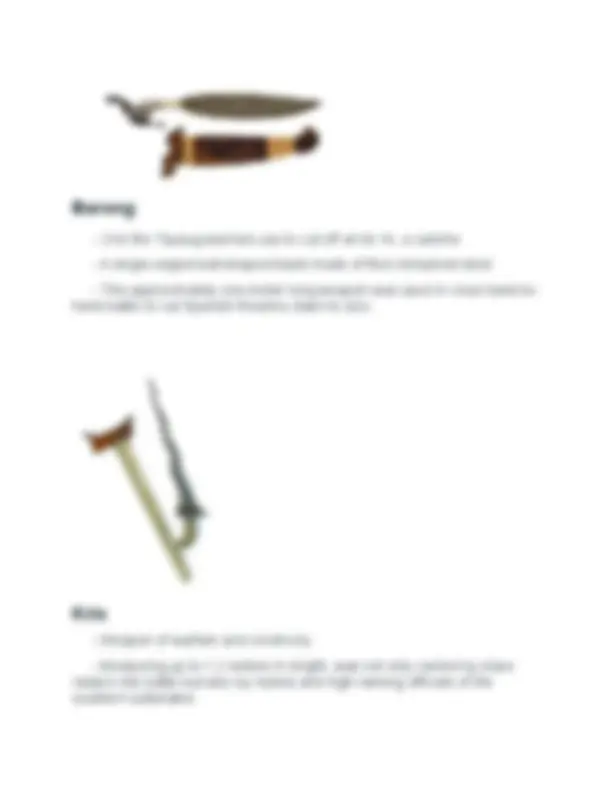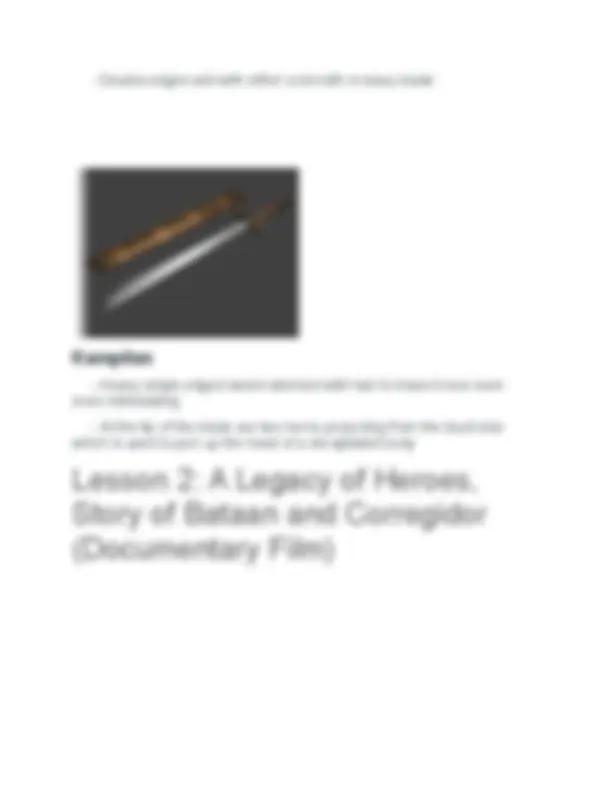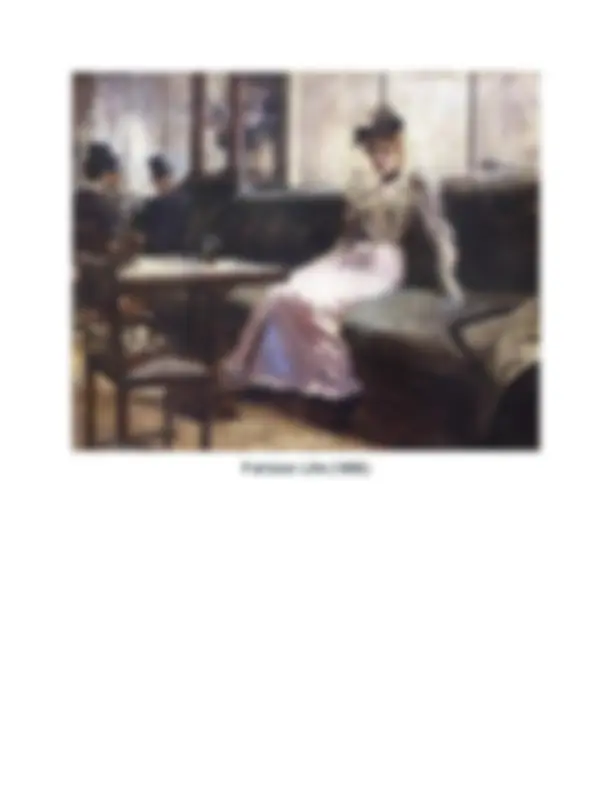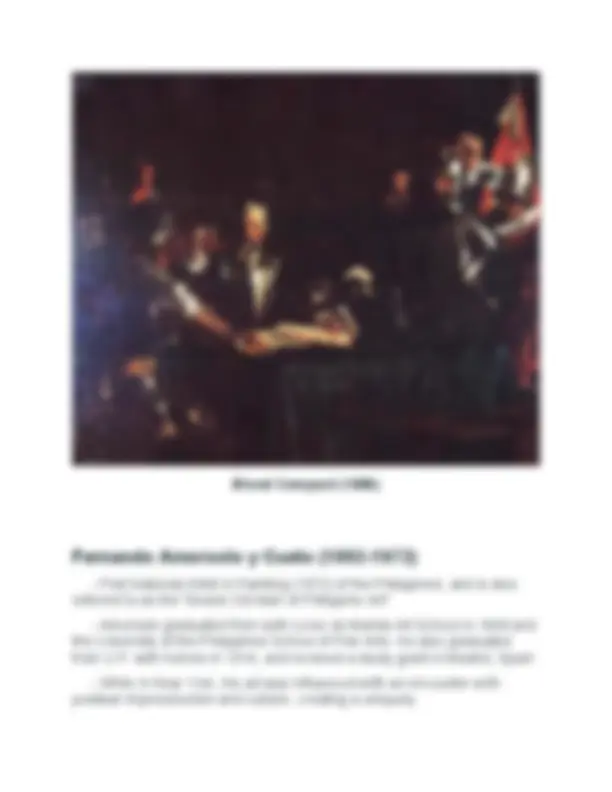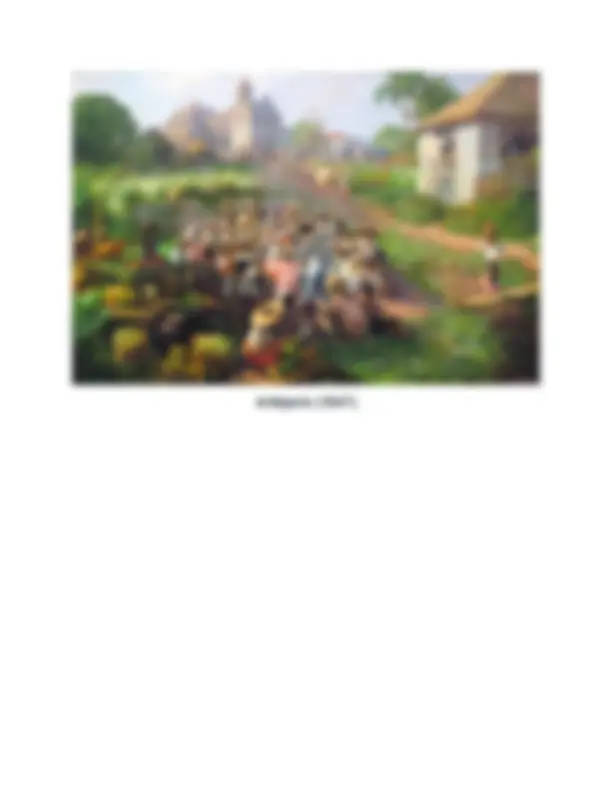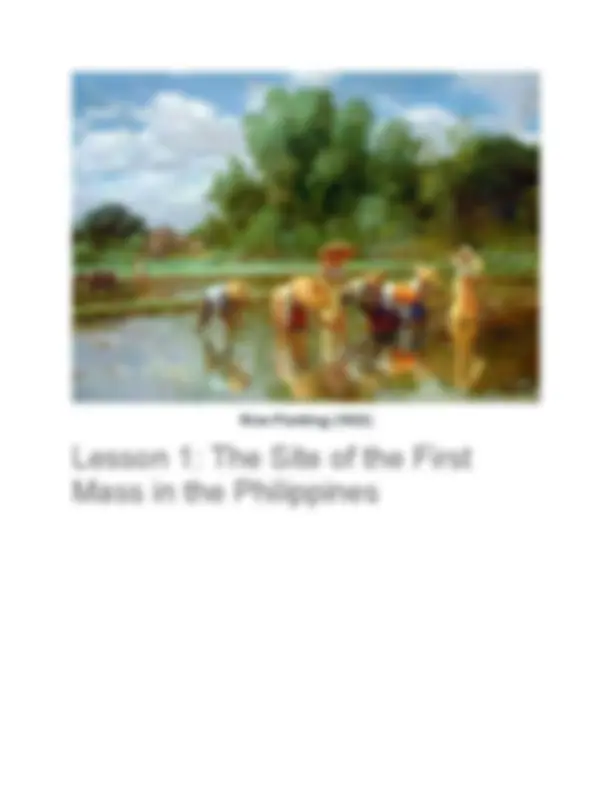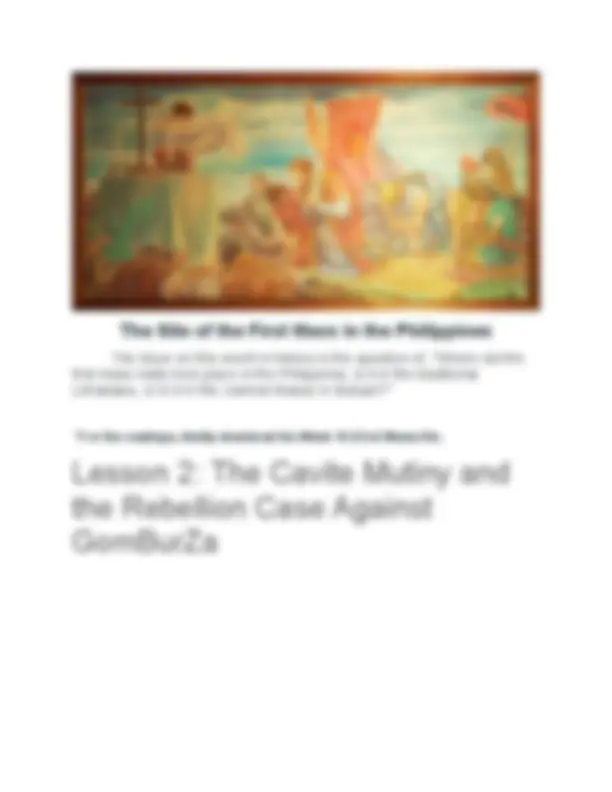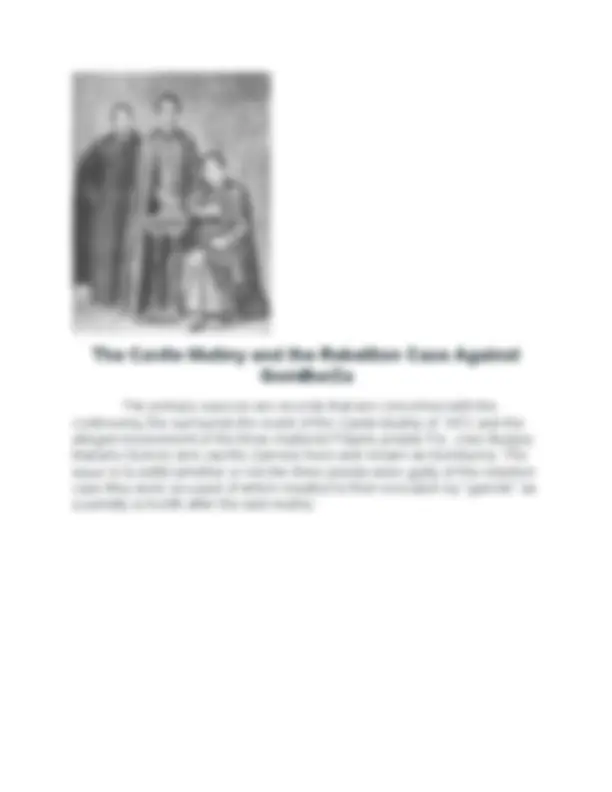Download RIPH 15.99 US$ / month 150 Premium points right away You can download any kind of docum and more Schemes and Mind Maps History in PDF only on Docsity!
Lesson 1: Excerpt from Apolinario
Mabini's The Philippine Revolution:
Chapters 9 and 10 [Memoirs]
Apolinario Mabini
- Filipino revolutionary leader, educator, lawyer and statesman who served first as a legal and constitutional adviser to the Revolutionary Government, and then as the first Prime Minister of the Philippines upon the establishment of the First Philippine Republic.
- He is regarded as the "Utak ng Himagsikan" or "Brain of the Revolution".
- Mabini performed all his revolutionary and governmental activities despite having lost the use of both his legs to polio shortly before the Philippine Revolution of 1896.
Lesson 2: Excerpt from Emilio
Aguinaldo's Mga Gunita ng
Himagsikan. [Memoirs]
Emilio Aguinaldo
- A Filipino revolutionary, politician, and military leader who is officially recognized as the first and the youngest President of the Philippines (1899–1901) and first president of a constitutional republic in Asia
Lesson 2: Excerpt from Alfred
McCoy and Alejandro Roces'
Political Caricatures of the
American Era
****For the readings, kindly download the Week 7 file.**
Lesson 1: Excerpt from Filipino
Grievances Against Governor
Wood by the Commission on
Independence
Leonard Wood
- a United States Army major general, physician, and public official. He served as the Chief of Staff of the United States Army, Military Governor of Cuba and Governor General of the Philippines. ****For the readings, kindly download the Week 8 file.**
Lesson 1: Raiders of the Sulu Sea
(Documentary Film)
Raiders of the Sulu Sea
- A Historiography documentary film focusing on Zamboanga City depicting how the Spaniards defended the city with the Fort Pilar as Spain’s last stronghold and bastion of defense and economic expansion in the South of the Philippines.
- It depicts the Southeast Asian flourishing free trading in the area and the adverse effects and repercussions when Europeans such as the English, Dutch and Spanish who wanted to control the economy as well to colonize and Christianize.
- The documentary centers on the activities of the slave raiders as a way of retaliation to the colonizers and a way to defend their way of life against oppression.
- The Sulu and Maguindanao sultanates were then the two main kingdoms controlling the Muslim colonies of the southern Philippines. With the king of Maguindanao, Rajah Dalasi, at the helm, they launched a bloody attack on Fort Pilar.
2. Illanun - The one which was very important in piracy history - Long-standing seafaring community 3. Balangingi Tribe or Samal - Occupied the chain of islands between Basilan and Sulu island - Also a long-standing seafaring community
Ancient Maritime Vessels and Weapons used by the
Moros
Garay
- Built from bamboo, wood, and the nipa palm and could carry more than 100 sailors.
- This single-sailed ship was 25 meters long and six meters across and housed a powder magazine and cannon at the bow.
- With 30 to 60 oars on each side, the garay was faster than any other seagoing vessel of its time
Salisipan
- Small boats designed for coastal raids
Kalis
- Sword with a mystical side
- Double-edged and with either a smooth or wavy blade
Kampilan
- Heavy single-edged sword adorned with hair to make it look even more intimidating
- At the tip of the blade are two horns projecting from the blunt side which is used to pick up the head of a decapitated body
Lesson 2: A Legacy of Heroes,
Story of Bataan and Corregidor
(Documentary Film)
A Legacy of Heroes, The Story of Bataan and
Corregidor
- It discusses World War 2 in the Philippines and how thousands of heroic young Filipinos braved the odds and struggled to defend and protect the freedom of their people and motherland.
- The film centers on the stories of valor and heroism by the gallant Filipino veterans of World War 2. Through the eyewitness accounts of patriotic Filipino and American men who fought, the documentary returns to the events of the war, beginning from the attacks of the Japanese at Pearl Harbor, Hawaii and then the Philippines immediately after, to the battles in Bataan and Corregidor and the Death March where courage and sacrifice rose to its heights creating a saga in Philippine history and a legacy of heroes that will always be remembered.
Lesson 3: Works of Juan Luna and
Fernando Amorsolo (Paintings)
Juan Luna y Novicio (1857 – 1899)
Juan Luna Want create site? Find Free WordPress Themes and plugins. Juan Luna Photo
Despite his commercial success and great talent, Juan’s life is overshadowed by the dark controversies he became involved in because of his jealous disposition and accusations at the loyalty of his wife, whom he accused of having an affair with Monsieur Dussaq, a surgeon. On September 23, 1892, in a blinding rage of jealousy, Juan murdered his wife, his mother-in-law, along with causing serious injuries to his brother-in-law. Juan met his own death in 1899, at the age of 42.
- A great Filipino painter, and occasionally a sculptor
- He was a prominent propagandist who pushed for political reforms along with Jose Rizal
- His victory taking the gold medal in the 1884 Madrid Exposition of Fine Arts for his “Spoliarium”, along with the 2nd^ prize silver of fellow Filipino painter Felix Hidalgo, created a celebration that would be a highlight in the memoirs of members of the Propaganda Movement The following are some of the most historically and culturally significant masterpieces of Juan Luna y Novicio: Spoliarium (1884)
Parisian Life (1892)
FERNANDO AMORSOLO National Artist for Visual Arts (May 30, 1892 – April 24, 1972) The country had its first National Artist in Fernando C. Amorsolo. The official title “Grand Old Man of Philippine Art” was bestowed on Amorsolo when the Manila Hilton inaugurated its art center on January 23, 1969, with an exhibit of a selection of his works. Returning from his studies abroad in the 1920s, Amorsolo developed the backlighting technique that became his trademark were figures, a cluster of leaves, a spill of hair, the swell of breast, are seen aglow on canvas. This light, Nick Joaquin opines, is the rapture of a sensualist utterly in love with the earth, with the Philippine sun, and is an accurate expression of Amorsolo’s own exuberance. His citation underscores all his years of creative activity which have “defined and perpetuated a distinct element of the nation’s artistic and cultural heritage”. The following are some of the most historically and culturally significant masterpieces of Fernando Amorsolo y Cueto:
The Making of the Philippine Flag
Rice Planting (1922)
Lesson 1: The Site of the First
Mass in the Philippines
The Site of the First Mass in the Philippines
The issue on this event in history is the question of, "Where did the first mass really took place in the Philippines, is it in the traditional Limasawa, or is it in the claimed Masao in Butuan?" ****For the readings, kindly download the Week 10 (First Mass) file.**
Lesson 2: The Cavite Mutiny and
the Rebellion Case Against
GomBurZa

